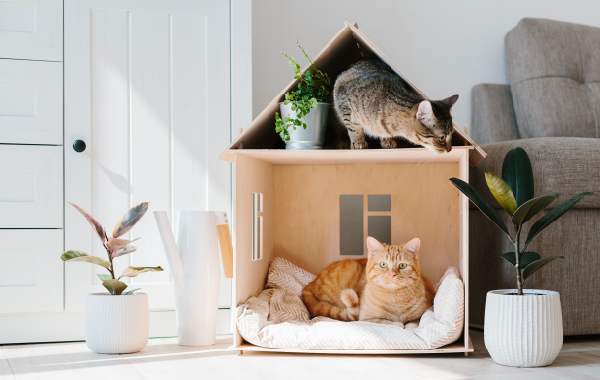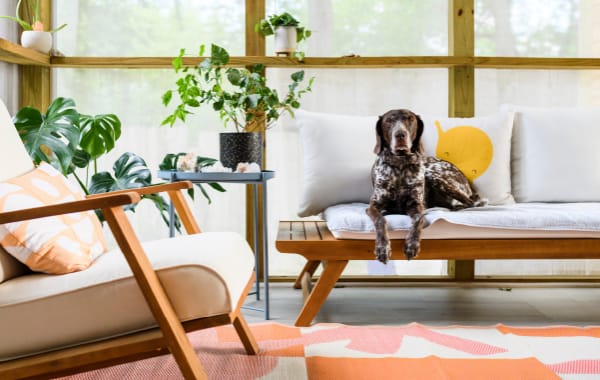Here’s How & Why You Should Allow Pets in Your Vacation Rental

Not-so-breaking news: people love their pets, and that includes showing them the world. In fact, a recent report found that over half of travelers surveyed want to bring their furry friends along for the adventure.
But here’s the thing: not all vacation rentals are pet-friendly. So if your home is open to four-legged companions, then you have a chance to capture guest bookings from a less-saturated market. (Not to mention you can give thousands of pet parents the vacation they’ve been dreaming of.)
If you want to get in on those pet-friendly dollars, there are a few key questions: how do you manage a pet-friendly vacation rental? And better yet, how do you pet-proof your investment? Let’s fetch those answers.
In This Article:
Why You Should Allow Pets in Your Airbnb
Furnishing Your Pet-Friendly Rental
Providing the Perfect Pet Amenities
Setting Pet Policies for Your Vacation Rental
What to Know About Charging Pet Fees
Why You Should Allow Pets in Your Airbnb

When venturing into the world of running a vacation rental, there are a ton of elements to juggle — and each one can feel like a make-or-break decision. One question you might face is, “Should I allow pets in my vacation rental?” Here are a few revenue-boosting reasons why you should.
1. Appeal to More Travelers
With 52% of pet parents planning to adventure alongside their four-legged friends this year, allowing pets in your vacation rental is one sure way to appeal to the majority — especially if you invest in a popular pet-friendly locale. These travelers may begin their search by applying the “pet-friendly” filter, because they are simply not interested in exploring properties where Rufus is excluded.
This means, by allowing pets in your Airbnb, you’ll automatically pop up in a much smaller pup-ulation of homes, putting you in the running for bookings when non-pet-friendly-homes are out.
What’s more? Your property shows up for people traveling without pets, too. So, you still compete at the same level you would normally and you could get a boost in bookings with a large group of tail-wagging travelers.
2. Boost Off-Season Occupancy
If your vacation rental is in a location where the primary draw of an area declines during a certain time of year (like a ski chalet at the height of summer), it’s important to think about ways to draw in guests during those slower seasons. One way to do that: tell travelers they can bring their pets along, since 7 in 10 pet parents say they’re more likely to travel if pets are welcome.
Tapping into this pet-friendly trend gives your home the added juice it needs to help travelers get excited about off-season activities — and convince them to choose your home over someone else’s.
3. Earn More Revenue
Do you know what better visibility, plus more bookings, plus a full calendar can add up to in short-term rental? More revenue. With the right policies and pet amenities in place, your investment can be both protected and profitable.
Furnishing Your Pet-Friendly Rental

With pet-friendly bookings on the horizon, it’s true that some might think your new linen couch is a scratching post — and that fringe rug may look like a rope toy to curious pooches.
So when it comes to furnishing a pet-friendly vacation rental, think about your long-term budget (you don’t want to replace the couch every year) and pet safety.
Anti-tip devices on furniture — like dressers, entertainment centers, or bookcases — can protect your belongings and guests. Providing pet or baby gates can help visitors close off certain areas to Fluffy. Keeping breakable and chewable decor out of reach is a wise move. And remember: washable items are king.
Luckily, some furniture companies now offer pet-friendly products with scratch- and stain-resistant fabric, machine-washable area rugs, and even bedding that’s pet hair-resistant.
Alternatively, leather is a popular pet-friendly choice. It’s easy to clean, stands up to scratches and stains, and even comes in stylish distressed options that hide imperfections. You can also consider tightly woven fabrics that won’t snag claws as easily, and choose pet beds, blankets, and rugs that can easily be thrown in the laundry.
Providing the Perfect Pet Amenities

When traveling, packing is hard enough for yourself, let alone including all of your four-legged companion’s toys, food, and accessories.
Make vacation easy for guests by providing things like complimentary pet treats as part of your welcome gift. You could also leave easily washable dog toys for them to play with (in addition to all the top amenities us humans are after) and pet-friendly towels — one of the most popular pet amenities mentioned in reviews.
To help you get those five-star reviews, vacation rental guests think there are a few other pet amenities you could consider having available for use:
- Food & water bowls
- Beds & crates
- Poop bags & leashes
- Pet/baby gates
- Fenced yard
- Comfortable green space
Setting Pet Policies for Your Vacation Rental

To run a pet-friendly vacation rental effectively, your house rules and policies should be clearly defined in your listing’s description and detailed in your welcome book. Make it easy for travelers to comply by providing tools like pet gates and waste bags for cleanup, a designated outdoor space for playtime and going potty, and special beds, blankets, crates, and towels for pets.
Remind your guests of any neighborhood or city rules, like leash laws. And go the extra mile by recommending nearby dog parks or pet-friendly businesses they can check out.
It’s worth noting that things like size limits and even the number of pets allowed can be difficult policies to enforce with each and every guest. Be thoughtful about what you’re asking for in your house rules, and stay flexible so you can maximize your earning potential. And remember, having the right damage protection program, professional cleaning partner, and property management team can make running a pet-friendly vacation rental easier.
Pet-friendly or not, a lack of cleanliness is one of the top reasons guests leave a bad review. Keep your home sparkling with our free cleaning checklists.
What to Know About Charging Pet Fees

Charging a pet fee to protect your vacation rental is a common practice today — and an expectation with many travelers. Whether you choose a nightly rate (often around $10-50 per night) or a flat fee (typically $50-100), this payment provides you with the necessary funds to cover added cleaning costs or possible damage that pets sometimes cause.
However, these can be difficult to enforce, since top vacation rental sites tend to handle fees differently. On top of this, to collect a pre-stay pet fee, guests have to disclose that they’re bringing Fido along — which doesn’t always happen. These incidents can admittedly result in frustration for owners, as it usually requires you to hunt down proof that a pet stayed in your home and follow up with the guest after they’ve already left.
That’s why we recommend considering an alternative to pet fees: insurance or a damage protection program that covers any post-stay damages caused by pets. When you find the right one, this can be a huge help in protecting your investment.
When you work with Evolve, our risk protection programs safeguard against damage caused by pets — at no added cost to you — so you don’t have to depend on tricky fees or deposits.
Turn Pet-Friendly Into Profit-Friendly with Evolve

When you raise your paw to vacation rental management, success starts with the right resources and strategies.
That’s why we created a free, downloadable guide filled with the secrets you need to turn your home into a passive income paradise — whether you allow pets in the home or not. Inside you’ll find:
- Exclusive strategies we use every day to help owners hit revenue goals
- Tips to create the perfect listing and set smart policies
- A game plan for meeting and exceeding guest expectations
